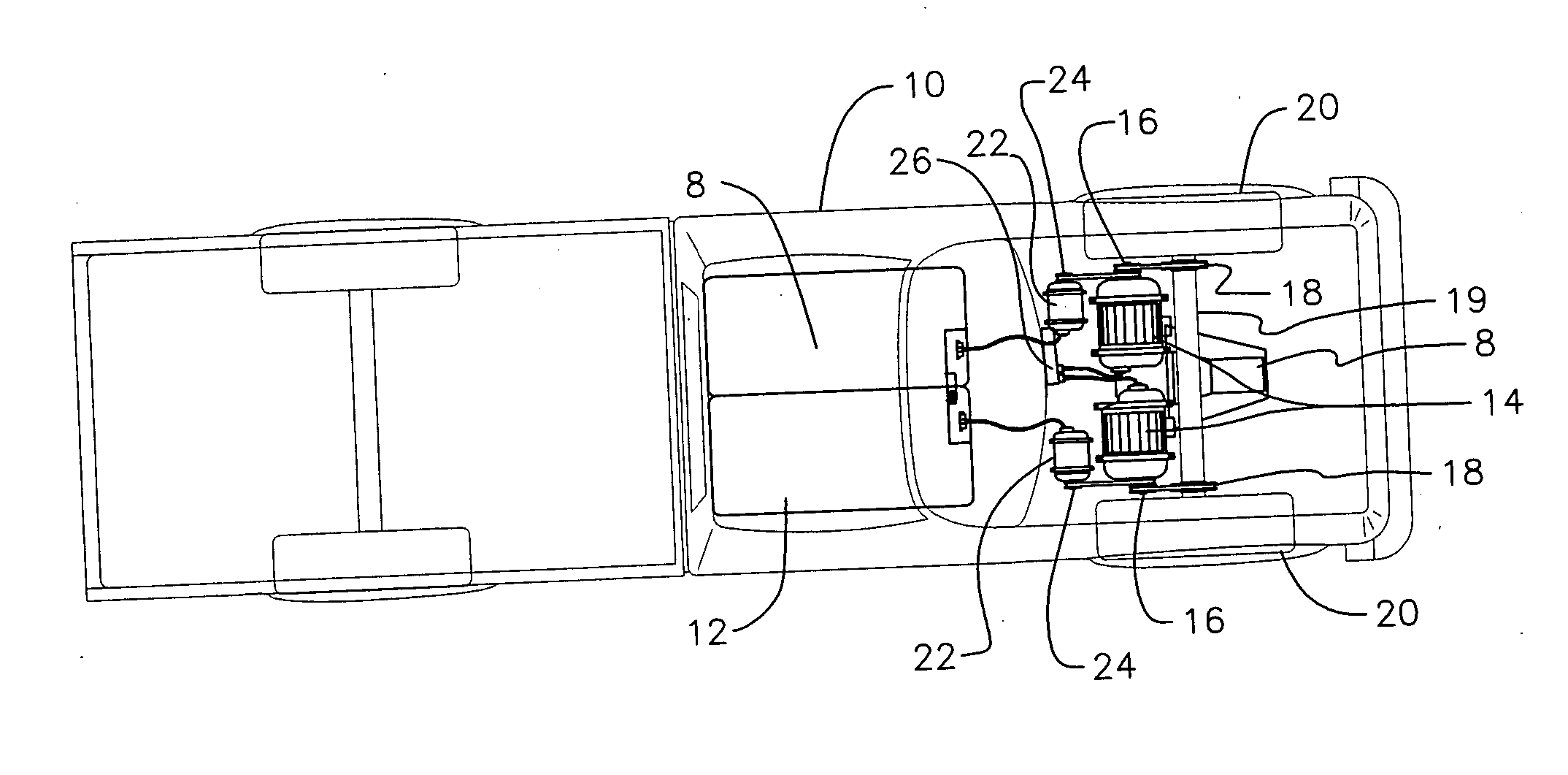Electric vehicle with regeneration
a technology of electric vehicles and regeneration, applied in the direction of machines/engines, propulsion by batteries/cells, transportation and packaging, etc., can solve the problems of reducing the efficiency of transportation of people and goods, and reducing the use of fossil fuel
- Summary
- Abstract
- Description
- Claims
- Application Information
AI Technical Summary
Benefits of technology
Problems solved by technology
Method used
Image
Examples
first embodiment
[0026] Referring to FIG. 1 and FIG. 2, a top schematic view and a side schematic view of a system of the present invention is described. A vehicle 10 has a rechargeable power source 12 that powers two motors 14 through a controller 26. The controller 26 is linked to a gas petal or other control mechanism and adjusts the speed of the vehicle 10 by controlling current flow to the motors 14. Each motor 14 has a dual pulley 16 for linking each motor 14 to both a drive pulley 18 and a generator pulley 24. In this embodiment a belt transfers rotational energy from each motor 14 to the drive pulley 18 and to the generator pulley 24, which, in turn, transfers rotational energy to the drive axle 19 and the generators 22, respectively. The axle is coupled to one or both drive wheels 20 and transfers rotational energy to the drive wheels 20 to cause the vehicle to move in a forward or backward linear direction. In some embodiments, the motors 14 are coupled to the drive train through a transmi...
second embodiment
[0030] Referring to FIG. 3 and FIG. 4, a top schematic view and a side schematic view of a system of the present invention is described. A vehicle 9 has a rechargeable power source 12 that powers three motors 14 / 27 through a controller 26. The controller 26 is linked to a gas petal 32 or other control mechanism and adjusts the speed of the vehicle 9 by controlling current flow to the motors 14 / 27. Each of the first two motors 14 have a dual pulley 16 for linking each motor 14 to both a drive pulley 18 and a generator pulley 24. In this embodiment a belt transfers rotational energy from each motor 14 to the drive pulley 18 and to the generator pulley 24, which, in turn, transfers rotational energy to the drive axle 19 and the generators 22, respectively. The axle is coupled to one or both drive wheels 20 and transfers rotational energy to the drive wheels 20 to cause the vehicle to move in a forward or backward linear direction. In some embodiments, the motors are coupled to the driv...
fourth embodiment
[0037] Referring to FIG. 7 and FIG. 8, a side schematic view and an expanded view of the present invention is shown. In this embodiment a forward mounted fan 40 is connected to a fan generator 44 as shown in FIG. 3 and FIG. 4. When the vehicle is stationary, no air travels in through an air passage 50 and the blades 48 of the fan 40 do not turn. In this embodiment, each fan blade 48 has a magnet material 62 affixed on an outer edge or tip and there is a plurality of electro-magnets 60 arranged in a sequential fashion so that when the vehicle is not moving, the electro-magnets 60 can be sequentially energized, much like an electric motor, causing the fan 40 to turn. The magnetic material is steel or iron or it is a permanent magnet made from iron or powdered iron. The magnetic material may be coated to reduce or prevent rust. Since the fan 40 is linked to the fan generator 44, the fan generator 44 will turn, thereby generating electricity that is used with the electricity generated b...
PUM
 Login to View More
Login to View More Abstract
Description
Claims
Application Information
 Login to View More
Login to View More - R&D
- Intellectual Property
- Life Sciences
- Materials
- Tech Scout
- Unparalleled Data Quality
- Higher Quality Content
- 60% Fewer Hallucinations
Browse by: Latest US Patents, China's latest patents, Technical Efficacy Thesaurus, Application Domain, Technology Topic, Popular Technical Reports.
© 2025 PatSnap. All rights reserved.Legal|Privacy policy|Modern Slavery Act Transparency Statement|Sitemap|About US| Contact US: help@patsnap.com



